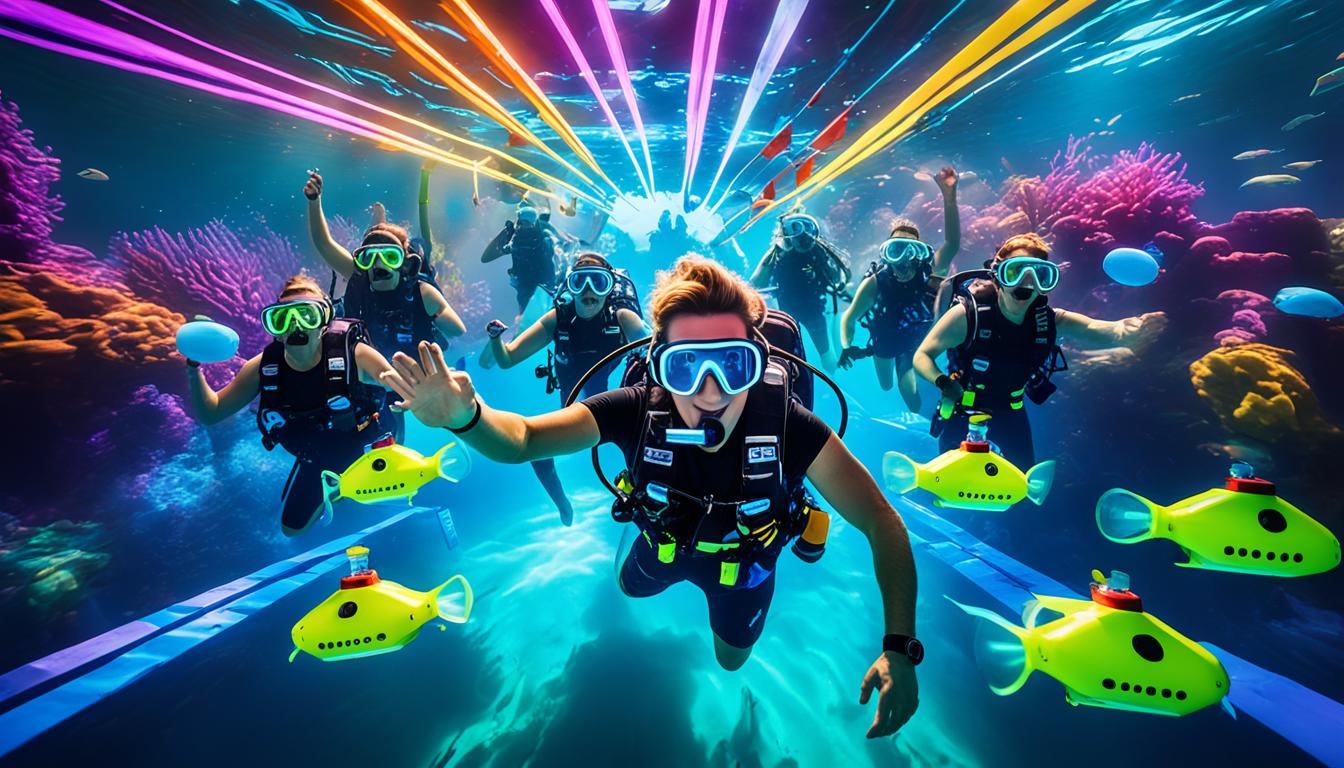Key Takeaways
- The Geneinno T1 is an advanced underwater drone designed for marine surveying with a 4K UHD camera and six thrusters for precise navigation.
- Its robust design is suitable for various underwater conditions, including strong currents and low visibility environments.
- Surveying with the Geneinno T1 involves planning the mission, deploying the drone, and collecting high-resolution data.
- The T1’s capabilities significantly enhance survey speed, efficiency, and data quality compared to traditional methods.
- Real-world applications include archaeological discoveries and environmental assessments, showcasing the T1’s versatility in professional surveying.
Uncharted Waters: The Geneinno T1’s Role in Advancing Marine Surveying
Imagine the ocean’s depths as a vast, unexplored frontier, brimming with mysteries waiting to be uncovered. Now, think of the Geneinno T1 as your trusty vessel, designed to navigate these uncharted waters, bringing the ocean’s secrets to the surface. With technology advancing at an impressive pace, the Geneinno T1 stands at the forefront, revolutionizing the way we conduct marine surveys.
What is the Geneinno T1 Underwater Drone?
The Geneinno T1 is not just any underwater drone; it’s a highly specialized tool crafted for the meticulous work of marine surveying. At its core, it’s equipped with a 4K UHD camera, providing crystal-clear images of the underwater world. But that’s just the tip of the iceberg. The T1 is also fortified with six powerful thrusters, granting it unparalleled stability and precision in the water. Most importantly, it’s built to withstand the rigors of saltwater environments, making it a reliable partner for both freshwater and marine explorations.
Core Features that Enhance Marine Exploration
Let’s dive deeper into what sets the Geneinno T1 apart from the rest. Here are the core features that make it an indispensable tool for marine exploration:
- High-Resolution 4K UHD Camera: Captures detailed underwater footage, essential for accurate surveys and inspections.
- 360° Attitude Control: Offers smooth and precise navigation, allowing the T1 to glide through water with ease.
- Durable Design: Engineered to endure the harsh conditions of underwater environments.
- Wireless Control: Operated via smart devices, providing flexibility and ease of use during missions.
- Extended Battery Life: Ensures longer operation times, enabling comprehensive surveys without frequent recharging.
With these features at your disposal, you’ll be equipped to tackle even the most challenging marine surveying tasks.
Real-time 4K Video and Imaging
When you’re surveying the mysteries of the deep blue, every detail counts. That’s why the Geneinno T1’s real-time 4K video is a game-changer. It provides not just images, but a window into the underwater world, with clarity so sharp you can count the scales on a fish or the polyps on a coral reef.
The imaging capabilities of the T1 go beyond just capturing visuals; they enable researchers to conduct detailed inspections and create vivid maps of the seafloor. This high level of detail is crucial for tasks like monitoring marine habitats, inspecting underwater structures, or searching for sunken treasures.
Integrating Sonar and Water Quality Detectors
Besides its impressive camera, the Geneinno T1 can be outfitted with sonar systems and water quality detectors. Sonar technology is invaluable for mapping out large areas of the seafloor, especially in murky waters where visuals are limited. It sends out sound waves that bounce back to create a picture of the underwater landscape.
Water quality detectors, on the other hand, measure parameters like temperature, pH, and turbidity. This data is essential for environmental assessments and understanding the health of aquatic ecosystems. By integrating these sensors, the T1 becomes a powerful tool for comprehensive marine research.
Extended Missions with Auxiliary Equipment
For those longer missions that require extended time under the waves, the Geneinno T1 can be equipped with auxiliary equipment. This includes additional battery packs for prolonged use, extended tether cables for deeper dives, and even specialized lighting to illuminate the darkest corners of the ocean.
Example: A marine biologist conducting a night survey of nocturnal sea creatures could use the T1’s additional lighting equipment to capture behaviors that are invisible to the naked eye during the day.
With these enhancements, the T1 can stay submerged for the duration of complex surveys, ensuring that no stone is left unturned and no data is missed.
Comparing Geneinno T1 with Traditional Survey Methods
- Traditional surveys often involve divers or tethered submersibles, which can be time-consuming and labor-intensive.
- The Geneinno T1 reduces the need for human divers, minimizing risk and allowing for surveys in more extreme conditions.
- While traditional methods can be disruptive to marine life, the T1’s quiet operation allows for more authentic observations of natural behaviors.
The advancements in technology embodied by the Geneinno T1 represent a leap forward in efficiency and effectiveness for marine surveying.
Traditional surveying techniques are often limited by human endurance and safety concerns. With the T1, surveys can be conducted deeper, longer, and in more adverse conditions than ever before. This means more data, better understanding, and ultimately, more informed decisions about our oceans.
Speed and Efficiency in Data Acquisition
One of the most significant advantages of the Geneinno T1 is the rapid pace at which it can gather data. Its ability to quickly maneuver through the water and capture high-resolution images and readings means that surveys can be completed in a fraction of the time it would take with traditional methods.
Cost-Effectiveness and Accessibility
While the upfront cost of an advanced tool like the Geneinno T1 may be higher than traditional survey equipment, the long-term savings are clear. Reduced labor costs, fewer safety risks, and the ability to gather more data in less time all contribute to the T1’s cost-effectiveness. Moreover, its ease of use makes it accessible to a wider range of professionals and enthusiasts alike.
Case Studies: Geneinno T1 in Action
The real proof of the Geneinno T1’s capabilities comes from its performance in the field. Let’s explore some instances where the T1 has made a significant impact in marine surveying.
In one case, a team of marine archaeologists used the T1 to locate and document ancient shipwrecks. The drone’s 4K camera captured intricate details of the ship’s construction, while the sonar system mapped the surrounding seabed, revealing artifacts buried in the sediment.
Underwater Archaeological Discovery
- High-resolution imaging allowed for the identification of historical artifacts without disturbing the site.
- Sonar technology provided a detailed map of the wreck site, aiding in further exploration and excavation planning.
- Water quality sensors monitored the environmental conditions to ensure the preservation of the site.
Thanks to the Geneinno T1, the team was able to conduct a thorough survey without the risks associated with deep dives, revealing a glimpse into our past that had been hidden beneath the waves for centuries.
Another noteworthy application of the T1 was during an environmental impact assessment. Researchers deployed the drone to monitor changes in a coral reef ecosystem before and after a major coastal development project. The data collected helped to inform conservation strategies and mitigate potential damage to the reef.
Case Studies: Geneinno T1 in Action
Real-world applications of the Geneinno T1 provide concrete evidence of its capabilities. From the depths of the sea to the conservation of marine life, the T1 is proving to be an invaluable asset in various underwater surveying scenarios.
Underwater Archaeological Discovery
The Geneinno T1’s precision and high-resolution imaging make it an ideal tool for underwater archaeological explorations. In one remarkable case, the T1 was instrumental in the discovery of a sunken vessel believed to be centuries old. Its 4K camera captured the intricate details of the ship’s remains, allowing archaeologists to analyze the wreck without disturbing its resting place.
The T1’s sonar system played a pivotal role in mapping the debris field, revealing a spread of artifacts that extended far beyond the main wreck site. This allowed the archaeologists to plan a more comprehensive excavation strategy.
Moreover, the water quality sensors provided real-time data on the site’s environmental conditions, which is critical for the preservation of sensitive artifacts. The T1 demonstrated that modern technology could peel back the layers of time, offering a non-intrusive means to explore our underwater heritage.
Environmental Impact Assessments
Environmental impact assessments are crucial for understanding how human activities affect marine ecosystems. The Geneinno T1 has been deployed in numerous studies to monitor the health of coral reefs, track pollution levels, and assess the impact of industrial projects on aquatic life.
In one instance, the T1 surveyed a coral reef before and after the construction of a seaside resort. By comparing the pre- and post-construction data, scientists were able to measure the project’s impact on coral health and fish populations. The T1’s data was instrumental in implementing measures to protect the reef and mitigate further damage.
The Geneinno T1’s ability to gather detailed data without disrupting the marine environment makes it a preferred choice for conducting sensitive environmental studies. Its use in these assessments not only helps in conservation efforts but also informs policy decisions and public awareness.
FAQs About Geneinno T1 for Surveying
When considering the Geneinno T1 for professional surveying, there are several questions that often arise. Here are the answers to some of the most common queries:
Is the Geneinno T1 Suitable for Deep-Sea Surveying?
Yes, the Geneinno T1 is well-suited for deep-sea surveying. Its robust design and extended tether allow it to dive to significant depths, providing access to areas that are otherwise unreachable by divers. The 4K UHD camera and additional lighting equipment ensure that high-quality imagery can be captured even in the darkest depths of the ocean.
Can the T1 Navigate Strong Underwater Currents?
The Geneinno T1’s six thruster design grants it the ability to maintain stability and maneuverability in strong underwater currents. This feature is critical for surveying in challenging conditions and ensures that the T1 can operate effectively in a variety of marine environments.
How Does the T1 Perform in Low Visibility Conditions?
In low visibility conditions, the T1’s sonar system becomes particularly useful. It can map the seafloor and detect objects that are not visible to the camera, ensuring that surveys can still be conducted effectively when visual clarity is compromised.
Can Geneinno T1 Integrate with Other Survey Equipment?
The T1 is designed with versatility in mind and can be equipped with various sensors and devices to enhance its surveying capabilities. This allows it to work in tandem with other survey equipment, broadening its application scope and making it a flexible choice for many different types of underwater investigations.
Is Training Required to Operate the Geneinno T1?
Operating the Geneinno T1 is straightforward, and users can quickly learn to control it via a smart device. However, for professional surveying purposes, some training is recommended to fully leverage the T1’s capabilities and ensure the collection of high-quality data.
Overall, the Geneinno T1 is a powerful tool that brings efficiency, precision, and safety to the field of marine surveying. Its advanced features and adaptability make it an essential instrument for anyone looking to explore and understand the underwater world.






